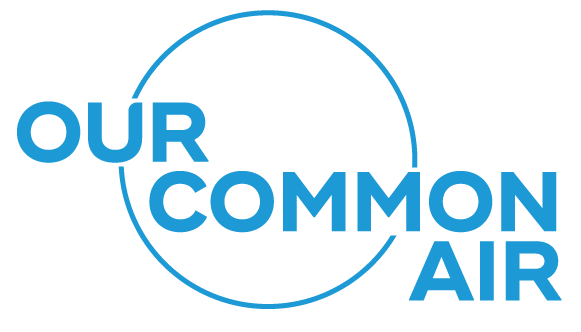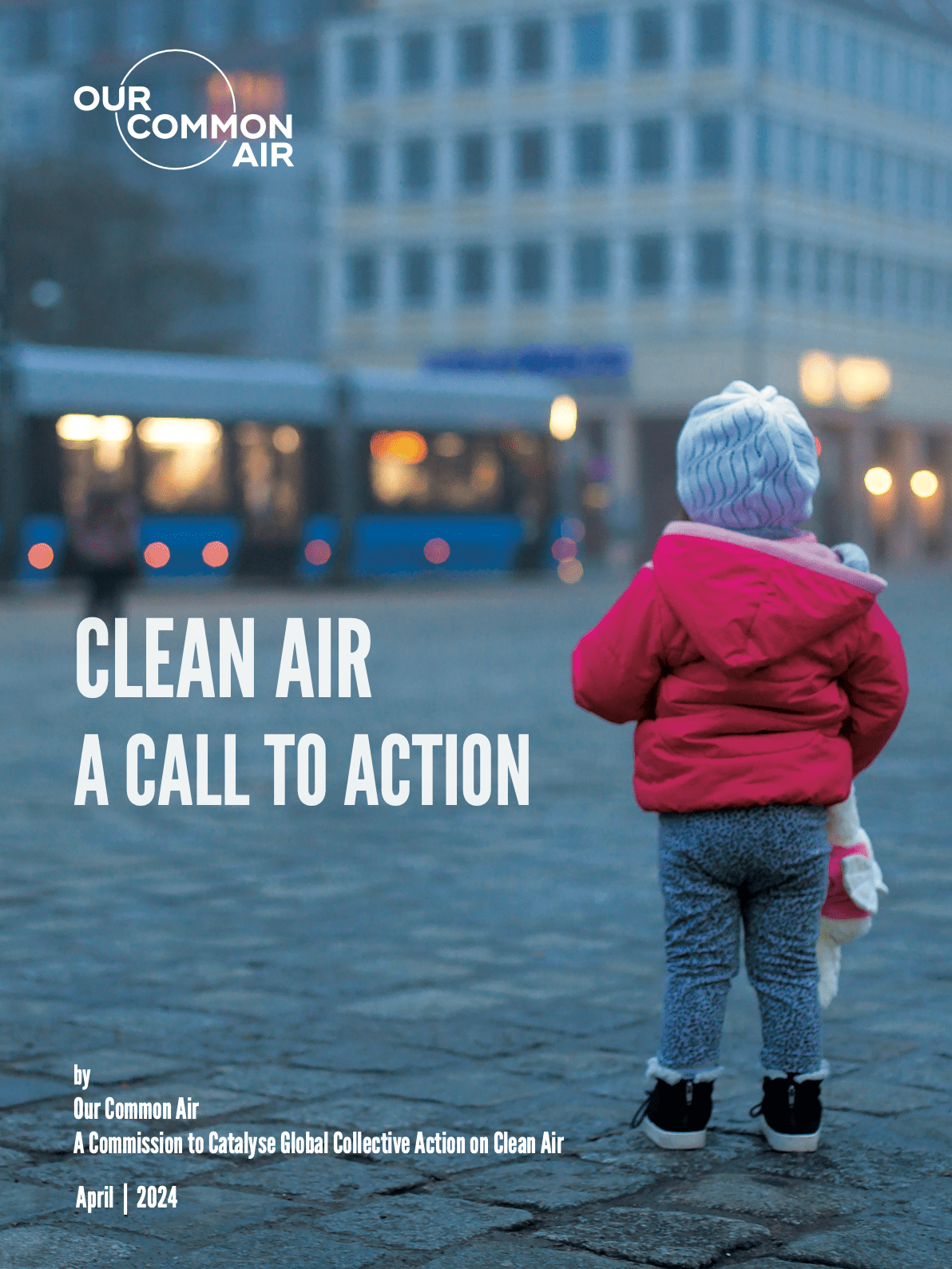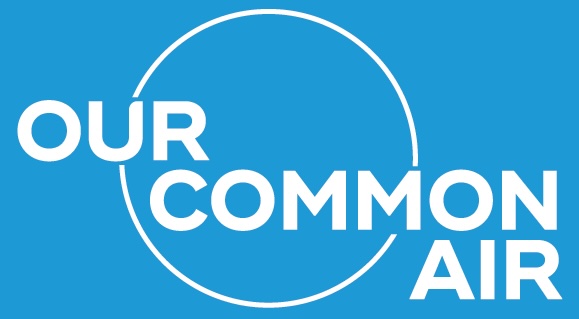
Clean Air: A Call to Action
This Call to Action is focused on making the economic case for clean air, financing the investments needed, setting targets and tracking progress, and sharing solutions.
April 2024
Authors: Our Common Air
Suggested citation: Our Common Air Commission (2024) Clean Air: A Call to Action. Available at https://ourcommonair.org/clean-air-a-call-to-action/
Summary of Recommendations
To achieve clean air for all, we call on all relevant stakeholders to:
1. Value clean air as an asset.
Governments, businesses, investors, multilateral development banks, and others must recognise and track the economic value that clean air creates, treating it as an ‘asset’ that benefits us all. Multilateral development banks should measure and value air quality impacts. Economic researchers should do more work to define and quantify impacts, including at the human scale (for example, the impact on exam results and future earnings); and think tanks and others should share evidence with policymakers, political leaders, and development financiers.
2. Finance the transition.
Public development banks and the wider development finance community should follow a three-part strategy to unlock the funding needed for clean air. First, they should make the case for clean air as an asset more prominent and specific within the development finance community. Second, they should work toward clear, shared metrics to make it easier and more rewarding for existing development finance to go to clean air projects. And third, they should create dedicated pillars of finance for clean air within existing resources and, where appropriate, launch clean air financing entities to secure additional funds.
3. Set WHO-aligned clean air targets and collaboratively track progress towards a common goal.
All governments and non-state actors such as cities, businesses and investors should set targets to limit levels of fine particulate matter air pollution (PM2.5) in line with World Health Organization (WHO) guidelines by 2030 — or, recognising each has different starting points and circumstances, an ambitious target based on the WHO interim guidelines — and annually report on progress.
A process should be developed to create a combined global target for PM2.5 reductions, akin to other global goals, such as net zero by 2050. This should prioritise and incentivise data-sharing by countries and utilise fully transparent methodologies. Efforts should be made to ensure participation and capacity building.
4. Work together to achieve solutions that benefit all.
Clean air is part of the global commons, so we must recognise a collective responsibility to co-develop clean technologies and provide affordable, sustainable investments across the world. Philanthropy, development finance, and existing sectoral entities should build a global solutions network that combines existing efforts to cut emissions and accelerate technological transformation. The solutions should be practical, strategic, and contextually relevant.
5. Commit to urgent action on short-lived climate pollutants.
Governments should integrate air pollution outcomes into the review of their Nationally Determined Contributions (NDCs). They should rapidly address short-lived climate pollutants (SLCPs), set ambitious SLCP emission reduction targets and take other steps, such as developing integrated air pollution, SLCP, and greenhouse gas inventories.
From Recognition to Responsibility
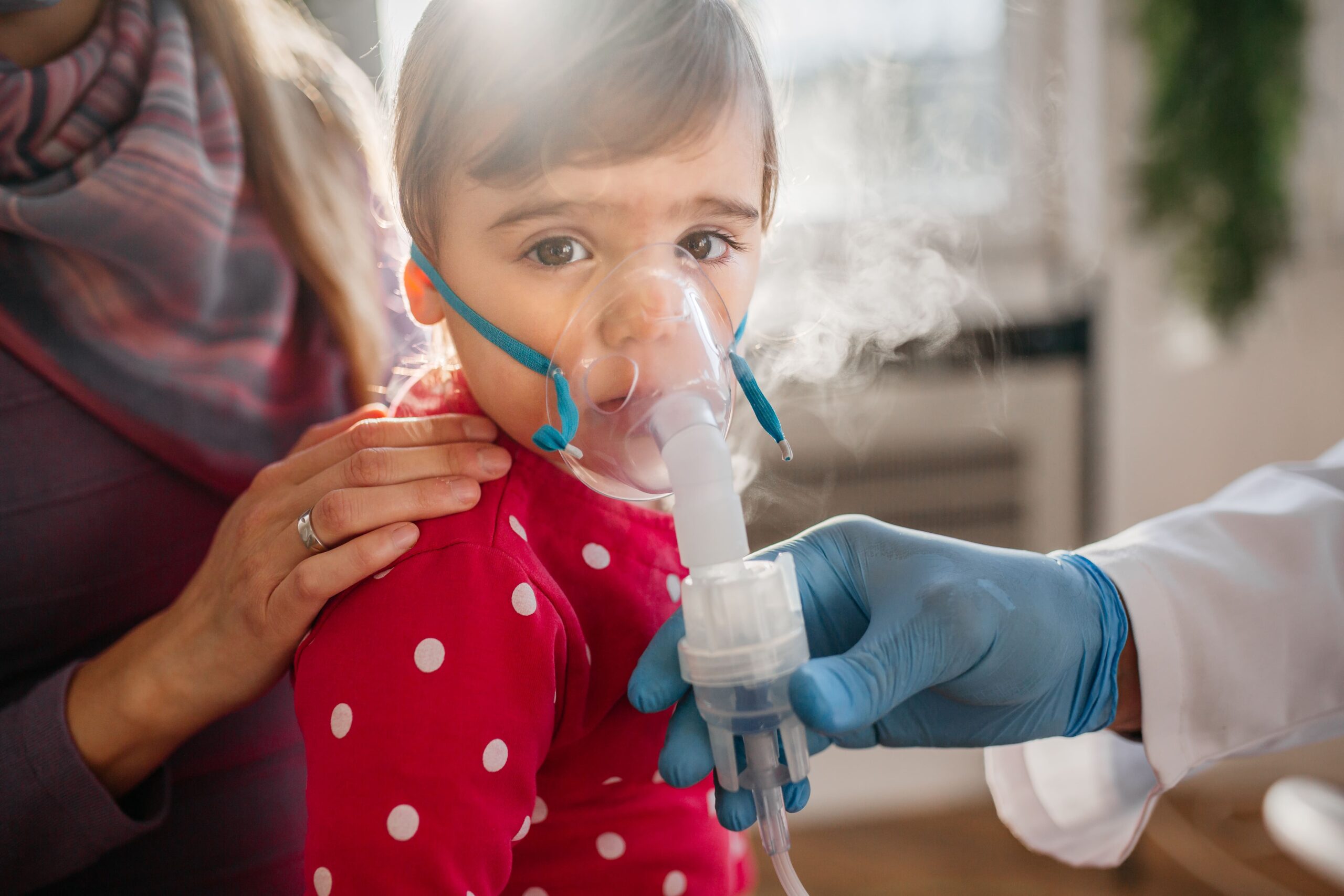
Image: iStock
Part of the obstacle to action on air pollution is the way people perceive the problem. A new narrative is needed in which air pollution is understood as something that affects us all, where coordinated action will bring more benefits than costs, and where delay is in no one’s interests.
We propose six attitudinal shifts to unlock action and catalyse progress.
First, we need to move from seeing air pollution as a liability to seeing clean air as an asset. The OECD estimates that approximately 1.2 billion workdays are lost globally each year due to air pollution, and this could reach 3.8 billion days by 20601. Studies have found that air pollution also impacts crop harvest, and corporate and foreign investment.2
Clean air is not just something that costs money to achieve, but is an asset that can improve health and productivity, and drive new models of economic growth, livelihoods, sustainable businesses, and sustainable development more generally.
Second, we need to shift from reactionary to data-driven interventions. Government actions have a higher chance of efficacy when backed by comprehensive, location specific data, better emissions monitoring, and updated inventories. While air pollution forecasting models capture pollution trends, their precision in predicting high-pollution episodes often remains limited.
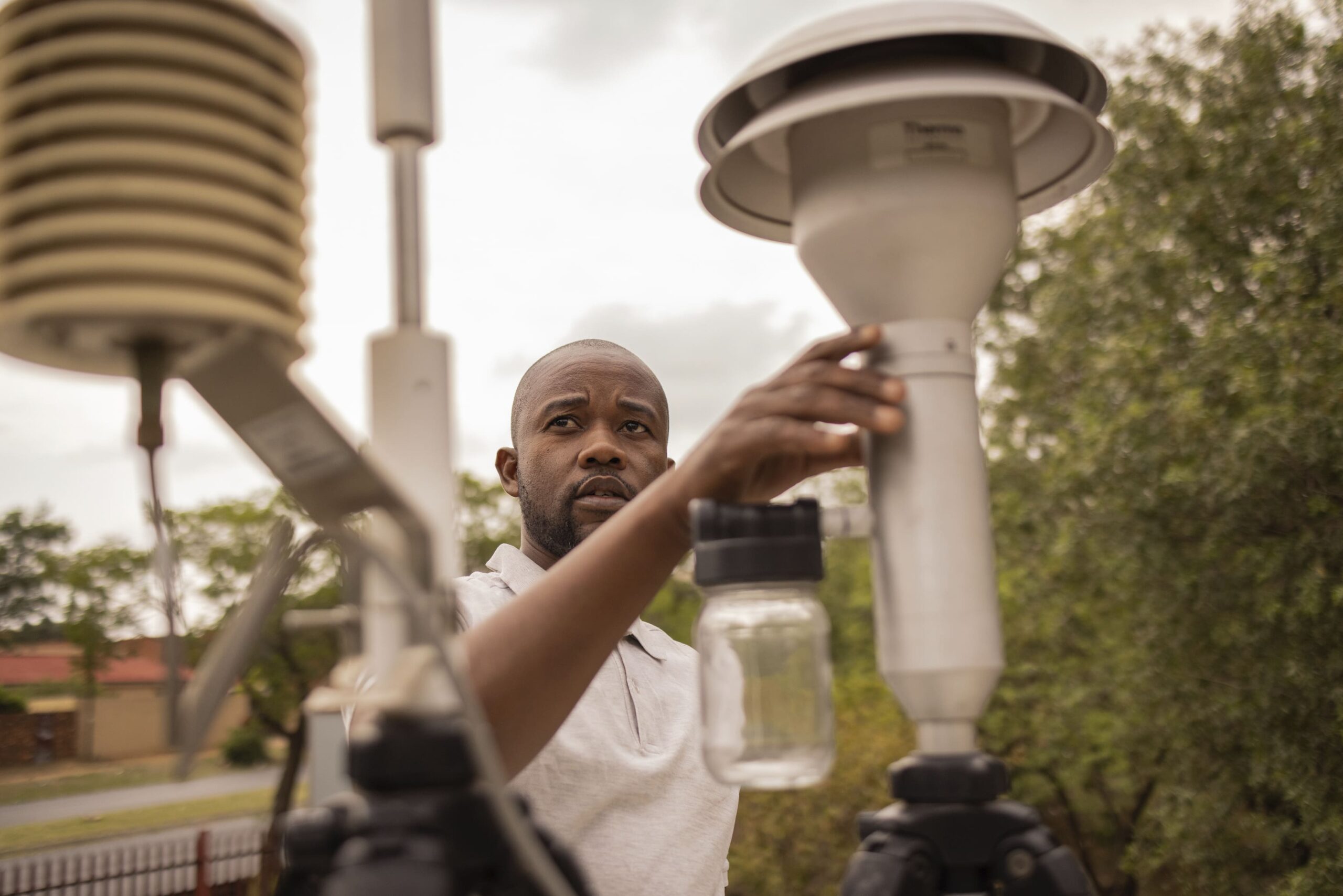
Image: Gulshan Khan/Climate Visuals
Policymakers and regulators can collaborate with research organisations to ensure timely information. Citizens’ demand for information on air quality throughout the year — or providing data themselves through citizen science — can push institutions to build better monitoring systems or make the information they already have transparent.
Third, we need to change from blaming the other to taking collective responsibility. Achieving clean air needs scale and coordination across levels of governance and sectors of the economy. Clean air plans need to be both sectoral in action and cross-sectoral in design — and account for transboundary pollution.
Different parts of the economy can derive mutual benefits from acting on air pollution. Emphasis on public transport can create business opportunities for electric buses but also generate demand for renewable power generation. Clean construction practices give incentives for alternative materials (including using waste) while dust control measures on construction sites could also help with designing urban waste management protocols.
Fourth, we need to shift from taking remedial measures to avoiding costs. According to the World Bank, the global cost of the health damage due to air pollution amounts to USD 8.1 trillion a year, equivalent to 6.1% of global Gross Domestic Product (GDP).3 Preventive measures are more cost-effective. Savings on public health expenditures could be redirected towards subsidising pollution abatement technologies or using green procurement practices to catalyse markets for cleaner technologies, products, and services.
In countries, regions, and cities where public spending on health is limited, such “savings” might not be evident upfront. But as the public health burden mounts, the long-term consequences for the economy will incentivise investment in a healthier and more prosperous society.
Fifth, we need to think less about the costs of abatement and more about the investment opportunities. The imperative of phasing down fossil fuel consumption comes with the opportunity to scale up clean energy, sustainable mobility, and greener industrialisation.
The International Energy Agency says investment in clean energy needs to reach USD 4.5 trillion a year by 2030 to limit warming to 1.5 degrees.4 Meanwhile, G20 leaders endorsed a Green Development Pact, in September 2023, which recognised that USD 5.9 trillion was needed by developing countries to achieve their climate targets by 2030, as well as USD 4 trillion a year for clean energy.5
This financing need is also an investment opportunity in geographies where the bulk of new energy infrastructure will be built. Raising sectoral ambitions in clean energy, industrial decarbonisation, sustainable mobility, or sustainable food systems can offer larger markets for economies of scale, reduce technology and investment risks, and lower the cost of finance for clean tech investments in developing countries and emerging markets.
Finally, we need to move from siloed investments to coordinated sustainable development. Acting on air pollution could help advance several Sustainable Development Goals (SDGs), including the ones on education, food security, equity, health, energy, sustainable cities, sustainable production and consumption, and climate action. At a time when many SDGs are off track, there is an urgent need to find synergies that deliver on multiple fronts while reducing the burden on stretched public finances.
An Action Plan
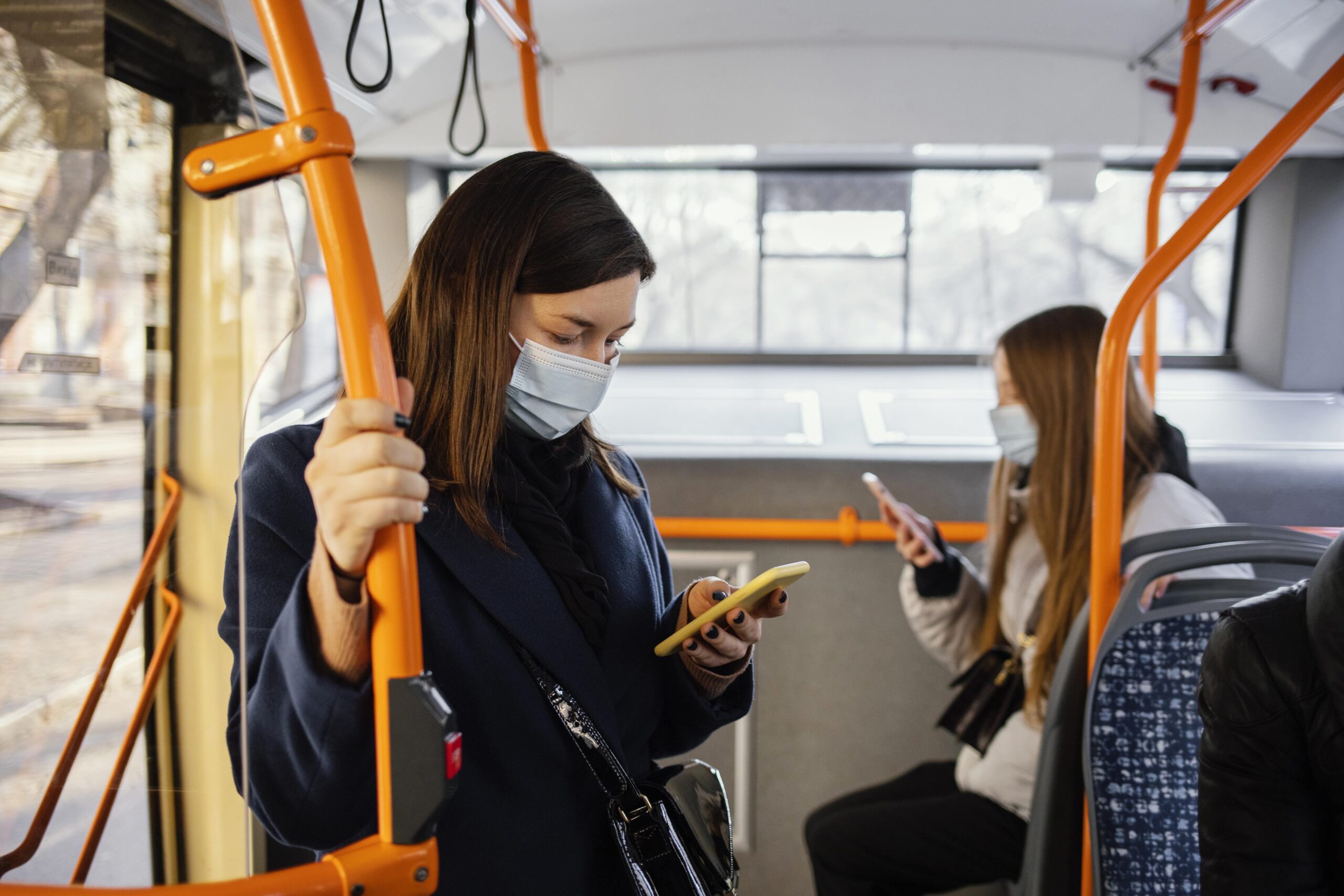
Image: Moveinsync.com
This Call to Action is focused on making the economic case for clean air, financing the investments needed, setting targets and tracking progress, and sharing solutions. These add up to a plan for addressing air pollution, in which everyone has a part to play.
These four planks of action are summarised at the start of this paper and outlined in more detail below.
Value clean air as an asset
While much discourse to date has emphasised air pollution as a harm to be mitigated, for real global change to take place it will be critical to recognise and value clean air as an asset that public, private, and community leaders should come together to create.
More work needs to be done to define and quantify the financial, health, ecosystem, climate, and other benefits that stem from clean air.
Clean air saves money. It reduces health costs, delivers greater productivity and higher levels of corporate and foreign investment, as well as improved returns in sectors from tourism to agriculture. It is unsurprising, therefore, that the United States found that every USD 1 spent on air pollution control yielded an estimated USD 30 in economic benefits.6
To further advance the work to quantify the value of clean air as an asset different actors will need to play their part.
Multilateral and regional development banks should incorporate economic impact analysis into their regular processes. They should produce relevant analyses of the economic benefits of air pollution reduction, either on a regional basis or via interventions in specific sectors, include air pollution action in refreshed country strategies, based on the economic analysis of the impacts of air pollution, and produce case studies of countries that have implemented clean air measures and seen economic benefits.
Economic researchers should produce studies about the economic impact of air pollution on specific sectors, demographic groups, socio-economic classes, etc., particularly to fill research gaps. They should produce data about the human-scale economic impact of pollution, for example, on exam results and future earnings. It would be valuable for researchers to form a coalition to produce a biennial ‘Economic case for clean air action’, with a public methodology that allows others to produce globally comparative studies. Researchers should also produce individual country and city reports which show the economic benefits and costs related to specific places and interventions.
Global and regional think tanks should convene fora to showcase success stories about how cities, regions, and countries have successfully curbed air pollution, and the associated costs and benefits. They should ensure that case studies include numbers relatable to individuals and, ideally, specific stories about real people.
Insurance firms should start incorporating air pollution-related health costs in risk assessments. Such risk assessments can help estimate and design more equitable access to (preventative and curative) public health interventions and infrastructure.
The Clean Air Fund’s The State of Global Air Quality Funding 2023 report found that less than 1% of international development funding and 2% of international public climate finance (USD 1.66 billion per year) has been committed to targeting outdoor air pollution over the last six years.7
Finance the transition
This paper lays out a three-part strategy for increasing the quality and quantity of investment in air quality. It notes the importance of not competing with other calls for finance and, thus, seeks to align with and leverage existing and growing pools of climate finance, health spending and other funds.
The three-part approaching to unlocking more funding for clean air is:
1. Elevate the goal: make the case for clean air as an asset more prominent and specific within the development finance community;
2. Adjust the flows: work toward simple, clear, shared metrics to make it easier and more rewarding for existing development finance to go to clean air projects;
3. Create dedicated pillars of financing for clean air within existing resources and create targeted financing entities for specific hard-to-fund purposes. Innovative financial structures are as important as simply ‘more’ finance.
To realise this strategy, a number of actors will have a role to play:
All public development banks should develop metrics that ensure air quality impacts are encouraged, tracked, and publicised across investment portfolios. Specific measures could include adding air quality objectives to sectoral initiatives, such as for buildings or transport.
They should also create dedicated pillars or programmes to finance air quality, include air quality goals in country strategies, and incorporate criteria to promote the funding of air quality initiatives through new mechanisms, such as the World Bank Global Challenge programmes.
The wider development finance community should create targeted clean air financing facilities for hard-to-fund purposes that leverage and integrate additional financial and capacity-building support from multiple public and private sources to address specific barriers and gaps, and build the pathways to channel such funds to integrated, evidence-based clean air action.
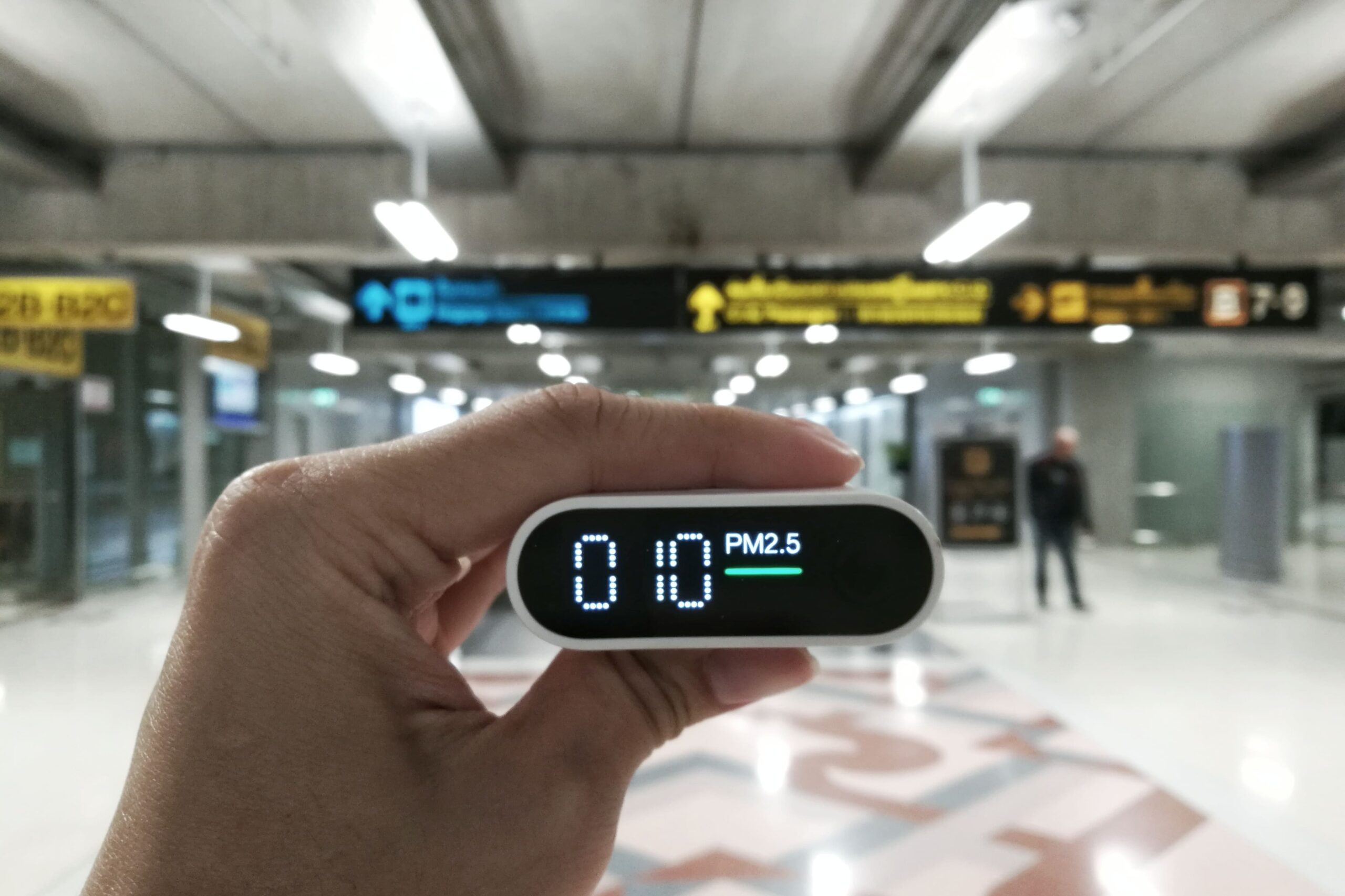
Image: iStock
All stakeholders should ensure that ongoing reforms in the international financial architecture give air quality due attention. They should demand that development banks invest in project preparation facilities for clean air projects to overcome capacity barriers, and increase the proportion of grant and concessionary funding for clean air.
Climate finance providers should recognise that climate adaptation financing should include air quality considerations. Examples include wildfire management and efforts to reduce black carbon deposition on snow and ice.
Philanthropists should recognise their role in catalysing clean air programmes at the local level, and making the transition more sustainable.
The private sector should demonstrate the business value of clean air by monitoring, reporting, and reducing air pollution along the value chain, investing in clean air solutions, and championing action on air pollution.
Government regulators should ensure that the true costs of imposing air pollution on economies are measured, evaluated, accounted for, and borne by polluters. Agencies and ministries should provide technical and financial support to smaller emitters such as farmers and households to help them switch to less polluting practices.
Investors in carbon emissions reduction and the authors of accounting frameworks for carbon should document health impacts of carbon reduction efforts.
National governments, who are spending six times as much on subsidising fossil fuel consumption as on commitments made under the Paris Agreement, should redirect fossil-fuel enabling subsidies toward clean air action.8
Public and private finance institutions should use green bonds, social bonds, results-based funding, and other financial tools to mobilise long-term capital and investments that help reduce emissions, replenish nature, and save lives.9
There is no single, accessible, up-to-date, credible, comprehensive database on air pollution levels and trends around the world — not even for PM2.5, much less for other pollutants. The lack of such a basic global air quality data system is an impediment to accountability and other incentives for clean air and climate action.
Set clean air targets for all and collaboratively track progress
What is required is a system for enhancing reporting and tracking of PM2.5, including setting targets as well as aggregating existing and new data to track progress globally. We propose a system that incentivises governments to measure, share, and model air quality data, while also providing data coverage where such air quality management infrastructure is lacking so that no location is left out.
Countries and non-state actors, i.e. cities, regions, business and investors, should set and achieve the WHO PM2.5 annual average guideline — or, recognising each has different starting points and circumstances, an ambitious target based on the WHO interim guidelines — by 2030.
To make this a reality, each should set a target and a pathway to meet it by 2026, implement new policies and programmes by 2028 to address the top sources of air pollution identified, and annually report on progress.

Image: iStock
Every country should have at least one sustained, high-quality government operated PM2.5 monitor that provides fully open data to the public by 2026 as a pathway toward more comprehensive networks established by government and/ or non-governmental actors.
A representative group from a broad array of sectors affected by or engaged in addressing air pollution should develop a combined global target for PM2.5 reductions, akin to other global goals, such as net zero by 2050, doubling energy efficiency, tripling renewables, or protecting 30% of the oceans.
Following an intergovernmental process, key actors should create a global system to collaboratively track PM2.5 levels at the national level for every country. This system should prioritise and incentivise data sharing by countries and utilise fully transparent methodologies.
Full participation in the collaborative global tracking process should be enabled via the creation of a financing mechanism that is dedicated to building air quality monitoring and management capacity in countries where there is currently no or little capacity.
Key regional agreements addressing transboundary air pollution

Map source: Our Common Air analysis
Note: Intergovernmental Air Pollution Network for Latin America and the Caribbean was reinforced in 2022 with launch of the new Regional Action Plan on Air Quality 2022-2025
Work together to achieve solutions that benefit all
At present, the overarching policy pressure for clean air action is weak — not all countries have air quality goals, and of those that do, few link the air quality targets to support for the clean air actions needed to reduce emissions. Support for clean air action exists but is fragmented across sectoral initiatives that are often motivated by other goals.
If air is part of the global commons, we must recognise a collective responsibility to co-develop clean technologies and provide sustainable investments across the world.
Air pollution does not respect political boundaries but there has been limited transboundary cooperation over clean air. The Convention on Long-Range Transboundary Air Pollution (CLRTAP) is an exception. The ASEAN Agreement on Transboundary Haze Pollution was signed in 2002. The Sustainable Use of Peatland and Haze Mitigation in ASEAN is another initiative managing risks of forest fires and transboundary haze. But these initiatives are dogged by stretched enforcement capacity, insufficient resources, and inconsistent citizen support.
However, other international agreements can catalyse actions that have clean air as a co-benefit. For example, in many cases, the NDCs that countries have developed under the UN Paris Agreement on climate change involve building clean energy infrastructure and cleaner urban transport systems, reduction in emissions intensity of economic activities, and rapid afforestation. Such actions can partly mitigate air pollution.
Governments should integrate air pollution outcomes into the review of their NDCs. They should rapidly address SLCPs, set ambitious SLCP emission reduction targets, and take other steps, such as developing integrated air pollution, SLCP, and greenhouse gas inventories.
We need to weave initiatives together to drive clean air action. We call on philanthropy, development finance, and existing sectoral entities to work together to build a global solutions network that combines existing efforts to cut emissions and accelerates technological transformation. The solutions should be practical, strategic, and contextually relevant.
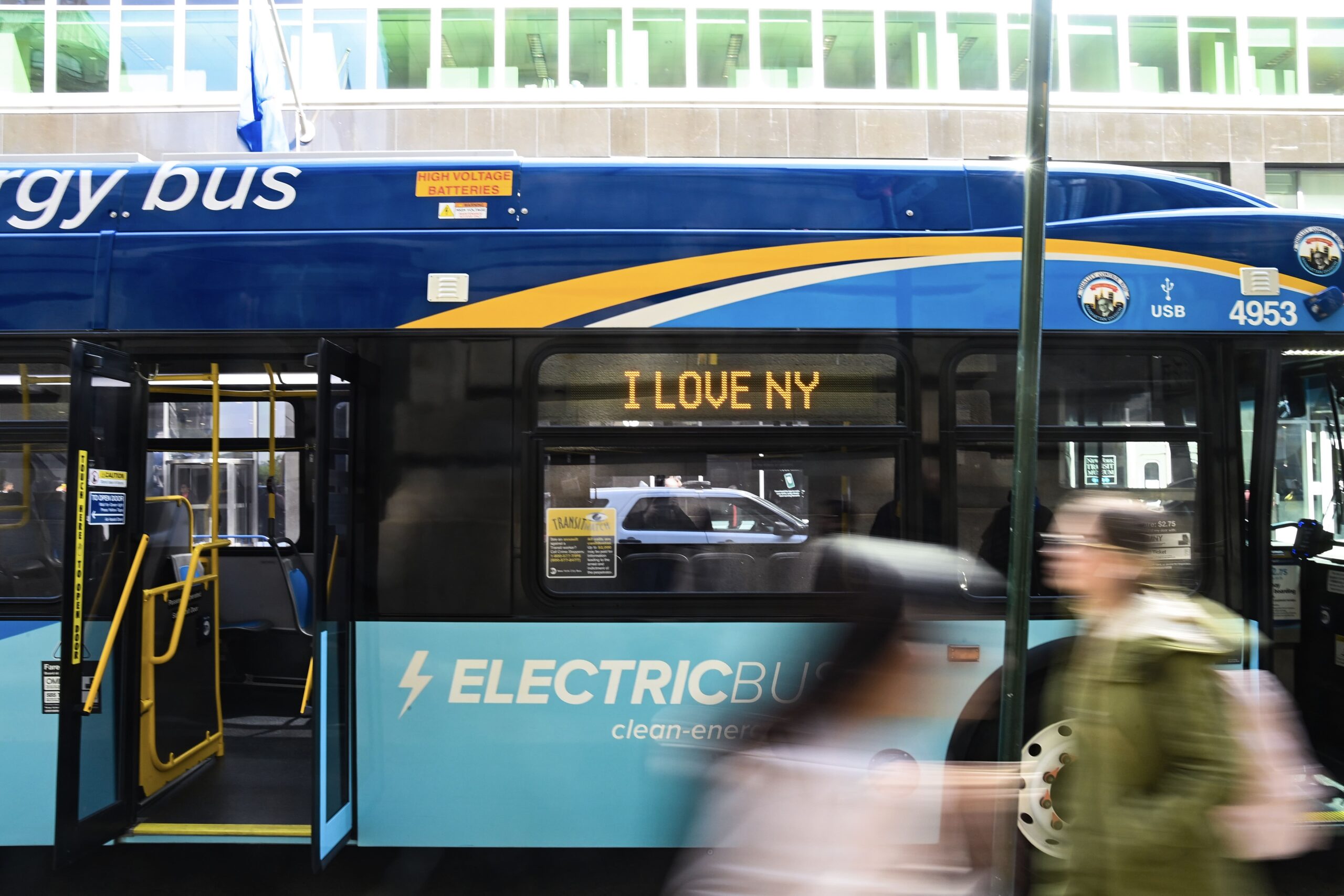
Image: Flickr
Conclusion
There is a huge opportunity for all countries and citizens to recognise the crisis of air pollution, and the enormous potential benefits of acting to address it: for health, our climate, the economy, and society.
As much as anything else, this is a crisis of the commons, where the fact that everyone shares responsibility for our global air quality means no one does enough to safeguard it. In a year of global elections — expected in more than 60 countries worldwide — the imperative for coordinated action, at the local, regional, national, and global level, has never been bigger, and nor has the chance to make a difference.
The Our Common Air Commissioners call on decision-makers to accept and implement their recommendations promptly, in the hope that this will be the year in which the world commits to achieving clean air for all.
Endnotes
1 OECD. 2016. “The economic consequences of outdoor air pollution.” OECD Publishing. https://doi.org/10.1787/9789264257474-en
2 UNECE. 2022. “New research confirms multi-billion dollar impact of air pollution on natural vegetation and crops.” 28 February, 2022. https://unece.org/climate-change/press/new-research-confirms-multi-billiondollar-impact-air-pollution-natural
3 World Bank. 2022. “The Global Health Cost of PM2.5 Air Pollution: A Case for Action Beyond 2021.” International Development in Focus. https://doi.org/10.1596/978-1-4648-1816-5
4 IEA. 2023. “Net Zero Roadmap: A Global Pathway to Keep the 1.5 °C Goal in Reach.” IEA. https://www.iea.org/ reports/net-zero-roadmap-a-global-pathway-to-keep-the-15-0c-goal-in-reach
5 Ministry of External Affairs, Government of India. 2023. “G20 New Delhi Leaders’ Declaration.” New Delhi, 10 September, 2023. https://www.mea.gov.in/Images/CPV/G20-New-Delhi-Leaders-Declaration.pdf
6 United States Environmental Protection Agency. 2024. “The Clean Air Act and the Economy.” Last updated on 16 January, 2024. https://www.epa.gov/clean-air-act-overview/clean-air-act-and-economy
7 Clean Air Fund and Climate Policy Initiative. 2023. “The State of Global Air Quality 2023.” Clean Air Fund. https://www.cleanairfund.org/resource/state-of-global-air-quality-funding-2023/
8 Richard Damania; Esteban Balseca; Charlotte de Fontaubert; Joshua Gill; Kichan Kim; Jun Rentschler; Jason Russ and Esha Zaveri. 2023. “Detox Development: Repurposing Environmentally Harmful Subsidies.” World Bank. http://hdl.handle.net/10986/39423
9 Clean Air Fund and Climate Policy Initiative. 2023. “The State of Global Air Quality 2023.” Clean Air Fund. https://www.cleanairfund.org/resource/state-of-global-air-quality-funding-2023/
